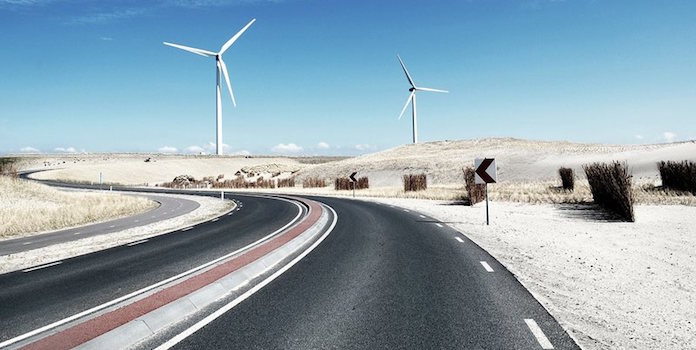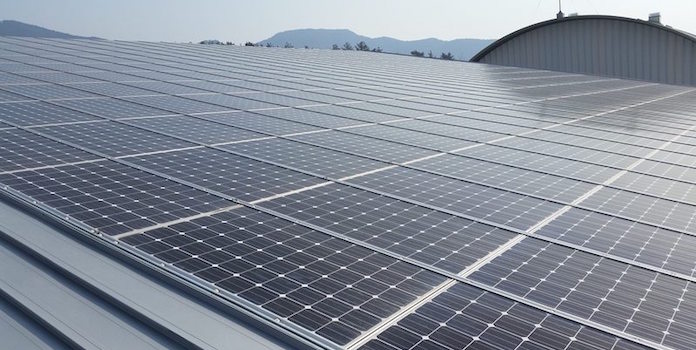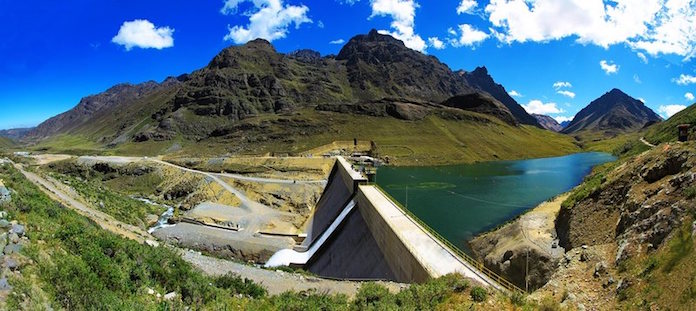Roadmap to Renewability – What 100% Renewable Could Really Look Like

How to achieve the ultimate dream of a world powered by 100% renewable energy
Over the last few years, a research team from Stanford University has published several articles detailing what our world would look like with 100% renewable energy and how we could get there. They call it a ‘roadmap’ to renewability.
Switching over to completely generating all our electricity from renewable sources is no easy task. Only around 15% of all our electricity in the US comes from renewable sources as of 2017, so we’ve got about 85% more to go. (And just FYI, hydro and wind account for about 6% each, biomass 2%, solar 1% and geothermal at 0.4%. Coal and natural gas make up 65% of all our energy generation).
Today, let’s take a look at this study to see what some really smart people think our infrastructure would look like with 100% renewably-sourced electricity. But first, why should we even bother?
Benefits of 100% renewable energy
Why are we even focusing on replacing all our fossil-fueled power with renewable alternatives? Well, there’s actually a lot of benefits to switching over, including:
- Reduced emissions. This is the obvious one. By curbing our own emissions, we can curtail global warming and its disastrous effects. Lowering emissions would improve the health of all living creatures as well.
- Energy independence. With renewable energy, there is no more importing and exporting of fossil fuel – it’s all right here at our very own fingertips.
- Stable energy costs. Because there is no fuel to purchase, costs to produce electricity via renewable sources is easy to predict and plan for. The only costs are operations and maintenance. No need to worry about fluctuating global fuel prices – what a nice idea! On top of this, without costly storage attached (like batteries), both solar and wind are actually cheaper to operate and build than coal or natural gas plants (p.2).
The building blocks of 100% renewable energy
The single biggest issue with renewable energy is its intermittency, or the fact that many renewable energy systems can’t produce power all the time or exactly when we want it. Solar installations only produce electricity when the sun is shining. Wind turbines only produce electricity when the wind is blowing. Wave energy only produces energy when there are waves.
On the flip side, coal and natural gas plants are easy to plan for. The operators can decide when and how much fuel to put in, allowing them to control exactly how much electricity is being produced at any given time. Need more electricity? Just fire up another power plant. This level of control allows us to enjoy the reliable, consistent electricity we all take for granted.
With renewables, though, it’s a bit more complicated. You can’t just ‘fire up’ a wind farm and know exactly how much electricity you’ll get. But, reaching this same level of control and predictability for renewable energy – at a reasonable cost – is the exact thing we need to figure out if we ever want to get to 100% renewable.
How do we solve this issue? There are actually three ways:
- Add energy storage. With Tesla producing its Powerwall, lithium-ion batteries for electricity storage are becoming a hot commodity, but there are many different ways to store energy, including ice, sand, water, and saltwater (yes, all of those). Storage, of course, adds expense to any project and it is storage’s one main detriment – it’s just so dang expensive! What do you do then? Take a look at #2!
- Diversify renewable sources. Instead of relying on a single energy source (wind, for example), diversify and install several sources. Each renewable source produces energy at unique times of the day: solar installations produce the most around noon, wind turbines produce the most at night, hydro power is around the clock. With good planning, you can have energy being created 24 hours a day from different sources.
- Decrease energy needs. We use lots of energy and our energy infrastructure is pretty inefficient. Here’s a crazy idea: instead of trying to produce enough renewable energy to cover our high demand, how about we take steps to cut out some of our energy needs first? While increased efficiency can’t cover ALL our energy needs (that would mean no electricity use, period), it is an important component of being 100% renewable.
So which one of the options above is best? In reality, moving to 100% renewable will require a mix of all of the above: efficiency, storage, and diversity in energy sources. Indeed, this is exactly what the Stanford researchers discuss.
The Stanford Project – roadmap to renewability
In 2017, a group of researchers at Stanford, led by Mark Z Jacobson, published an article detailing a ‘roadmap’ to worldwide 100% renewable energy solely from wind, water, and sun. The project focused not just on switching over our electricity generation to renewable sources, but included all forms of energy, including transportation, agriculture, and industry.
The researchers postulated that going 100% renewable by 2050 (a huge endeavor) would enable us to avoid a 1.5 degree Celsius increase in global temperature (considered by many to be the global warming ‘tipping point’ where there’s no going back).
The team produced an individual ‘roadmap’ for each country and US state they studied, breaking down exactly where renewable energy would likely come from. For all countries, most of the energy production typically falls around photovoltaic solar and wind energy.
The US, for example, would likely rely on 9 different energy sources, mostly solar and wind, including:
- Residential solar: 14.5%
- Utility-scale solar: 19.5%
- Concentrated solar: 11.5%
- Commercial/government solar: 11.8%
- Onshore wind: 21.3%
- Offshore wind: 17.1%
- Wave energy: 1.1%
- Geothermal: 0.4%
- Hydroelectric: 2.8%
Of course, along with these energy sources, the authors count on energy storage to balance out energy needs at certain times. These storage devices include solar thermal heat and geothermal heat, as well as additional concentrated solar power to meet peak demands. (p.5 of the report linked above)
The authors also note that we could drop our energy needs by over 40% simply through renewable sources’ greater efficiency in producing energy and by adopting end-use efficiency measures to lower our energy needs.
We’re of course only scratching the surface here of what a 100% renewable world would look like, and what it would take for us to get there. In real life, meeting this goal, or even getting close, would require our entire society to take a singular view of the importance of energy, health, and the environment. There would also need to be a huge shift in public policy. It would be hard, long-term work. But the benefits outweigh the drawbacks any day.
If you want to learn more, The Solutions Project, a 100% renewable advocacy group, publishes the Stanford report’s findings in super-fun infographics. I’d definitely encourage you to go check it out and find your country and/or state!
In the end, it’s not a matter of if we’re going to move to renewables. It’s a matter of how long will it take us to realize we need to.



